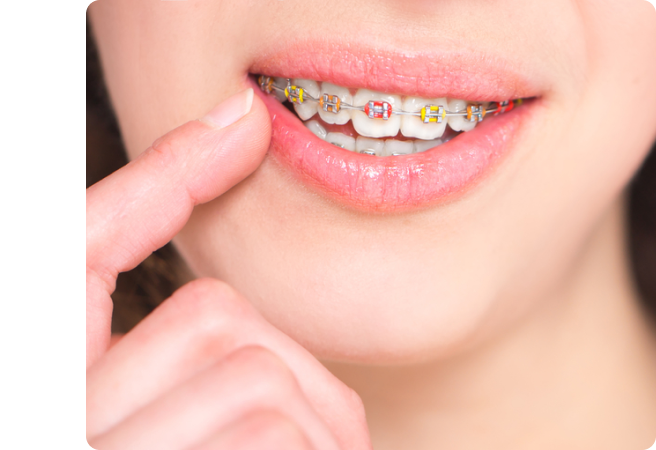Choosing the Best Replacement for Missing Teeth: A Practical Guide
What is the best option for replacing missing teeth?...


Bridges are used to replace a single tooth or multiple teeth that have been lost. Bridges rely on existing tooth structures on either side of the missing teeth, which are prepared with a crown and fused to prosthetic teeth to ‘bridge’ the gap. Bridges are permanent solutions to dental problems, such as missing teeth, weakened tooth structure or large fillings.
The metal braces we use are very small but can be made fun with colours applied. Perfect for young teenagers, they can match their favorite team, have Christmas or school house colours or join with their friends in wearing the same colour combinations. Let your imagination run wild!
If you’re ready for a smile that transforms your appearance, Braces may be your answer.


At your dental bridge consultation your dentist will examine your mouth to determine what type of bridge is best for your tooth gap. First, they will make sure your neighbouring teeth are healthy, free of decay and strong enough to support a dental bridge. During a traditional dental bridge procedure, your dentist will shape your abutment teeth down before creating a mould to make the bridge. Dental bridges are usually completed in two visits. At your first appointment, your dentist will prepare and install your crowns and install a temporary bridge while the permanent bridge is made.
During the second appointment your permanent bridge is attached to your crowns. For implant-supported bridges, your dental implant will be installed first. Typically, it only takes a few weeks between the preparation of your dental bridge and the final installation. However, implant-supported bridges take a lot longer. This is because dental implants have a longer recovery time. After the placement of your implant it can take several months before the bone and gums are fully healed. Once healed your bridge can be fitted in a matter of weeks. Your dentist will then either screw or cement the bridge in place.


Dental bridges are a great solution for permanent tooth loss. Whether you have one, two or three missing teeth, a dental bridge, crown or dental implants can help restore your smile and give you back your confidence. If you are interested in a dental bridge, book a dental checkup with Gentle Dental. Our dentists will examine your teeth and talk to you about the best restorative option. Dental bridges can be installed in two appointments. The cost of a dental bridge depends on what type of bridge you require and how many crowns or implants you need.
If you are missing teeth, there are alternatives to dental bridges. A dental implant can be used to fill the gap. False teeth, also known as partial dentures, are another option. The downside to having dentures is that they need to be removed to be cleaned. As dental bridges are fixed into your mouth, they are a permanent solution for a missing tooth. Like natural teeth, you can clean your dental bridge by brushing twice a day and flossing underneath the pontic (fake tooth). Taking good care of your natural teeth is crucial. Dental implants can last a long time. However, they can fail if your natural teeth start to decay or plaque builds up beneath the pontic and causes gum disease.
There are four main types of permanent bridges used by dentists. A traditional dental bridge is the most common. This type of dental bridge involves three teeth where two dental crowns support a fake tooth in the centre. A traditional bridge is the best option for a missing tooth that has two healthy teeth on either side. To create a traditional dental bridge, the dentist reshapes the healthy teeth so that a dental crown can be placed over top. These crowns are then bonded to a fake tooth that will fill the gap in your smile. Traditional dental bridges are usually made from porcelain-fused-to-metal or ceramics.
Cantilever bridges use a single natural tooth as an anchor. These are typically used when there is no tooth on one side of the dental bridge or when there aren’t two healthy teeth to support a traditional dental bridge. Cantilever dental bridges are usually used at the front of the mouth. Back teeth need to sustain a lot of force for chewing. Since cantilever bridges are only supported by one tooth, they can put too much pressure on the crown. However, cantilever bridges are a good option when there is no secondary support tooth to use as an attachment to the bridge.
Maryland dental bridges are similar to traditional dental bridges. Maryland bridges use two natural abutment teeth on either side of the tooth gap. However, rather than using dental crowns on these teeth, a Maryland bridge uses metal or porcelain to bond the fake tooth to your natural teeth. This type of dental bridge can only be used when there are natural teeth on either side of the tooth gap.
Implant-supported dental bridges use dental implants rather than crowns as the abutment teeth. Implant-supported bridges are a good option when there are several missing teeth as they are sturdy. They also don’t require healthy teeth to be ground down and fitted with crowns.
Dental bridges are a permanent solution for tooth loss. There are many reasons you may choose to get a dental bridge fitted. Some people don’t like having a gap in their smile. Dental bridges look just like real teeth and are a great way to gain confidence if you feel self-conscious about your tooth gap. Filling the gap between your teeth also helps your neighbouring teeth to stay in place. Over time, the teeth either side of your gap may lean in. A bridge provides support to your adjacent teeth, can improve your bite and make eating and chewing feel more natural and comfortable.
There are four main types of permanent bridges used by dentists. A traditional dental bridge is the most common. This type of dental bridge involves three teeth where two dental crowns support a fake tooth in the centre. A traditional bridge is the best option for a missing tooth that has two healthy teeth on either side. To create a traditional dental bridge, the dentist reshapes the healthy teeth so that a dental crown can be placed over top. These crowns are then bonded to a fake tooth that will fill the gap in your smile. Traditional dental bridges are usually made from porcelain-fused-to-metal or ceramics.
Cantilever bridges use a single natural tooth as an anchor. These are typically used when there is no tooth on one side of the dental bridge or when there aren’t two healthy teeth to support a traditional dental bridge. Cantilever dental bridges are usually used at the front of the mouth. Back teeth need to sustain a lot of force for chewing. Since cantilever bridges are only supported by one tooth, they can put too much pressure on the crown. However, cantilever bridges are a good option when there is no secondary support tooth to use as an attachment to the bridge.
Maryland dental bridges are similar to traditional dental bridges. Maryland bridges use two natural abutment teeth on either side of the tooth gap. However, rather than using dental crowns on these teeth, a Maryland bridge uses metal or porcelain to bond the fake tooth to your natural teeth. This type of dental bridge can only be used when there are natural teeth on either side of the tooth gap.
Implant-supported dental bridges use dental implants rather than crowns as the abutment teeth. Implant-supported bridges are a good option when there are several missing teeth as they are sturdy. They also don’t require healthy teeth to be ground down and fitted with crowns.
Dental bridges are a permanent solution for tooth loss. There are many reasons you may choose to get a dental bridge fitted. Some people don’t like having a gap in their smile. Dental bridges look just like real teeth and are a great way to gain confidence if you feel self-conscious about your tooth gap. Filling the gap between your teeth also helps your neighbouring teeth to stay in place. Over time, the teeth either side of your gap may lean in. A bridge provides support to your adjacent teeth, can improve your bite and make eating and chewing feel more natural and comfortable.
Learn more about dental restoration and how to care for your teeth from our latest blog posts.
What is the best option for replacing missing teeth?...
Two popular options for creating a lovely smile are a...
Here are some tips for post-surgery care and long-term...
A common misconception about dental fillings is that...
Root canals might seem scary, but the procedure is...
If you’ve ever had tooth decay, your dentist may...
Imagine if rather than getting a filling to fix tooth...
If you have tooth decay, your dentist may ask you...
Wisdom tooth extraction is a surgery that removes one or...
You can chew food with a dental bridge. Dental bridges are strong and improve the integrity of your smile. However, some dental bridges are slightly stronger than others. A dental bridge with two healthy teeth either side of your gap is optimal for your back teeth and will withstand the force of chewing hard foods. There are some food and drinks you should avoid after getting a dental bridge. Sticky foods can cause damage to your dental bridge, especially if your bridge is new and has not had enough time to bond fully with your abutment teeth. Avoid gum, caramel, toffee and other sticky foods.
Dental bridges typically last between 10 and 15 years. The good news is, if properly installed and well looked after they can last even longer. What your dental bridge is made from will affect its longevity. Ceramic bridges are made from porcelain and zirconium and are quite hardy. However, porcelain can be brittle and isn’t always suitable for bridges placed at the back of the mouth. Abutment teeth also influence the longevity of a dental bridge. If your neighbouring teeth aren’t healthy or you fail to care for them over time, your dental bridge may not last as long.
Like your natural teeth, your dental bridge requires daily care to keep your surrounding teeth and gums healthy and free of bacteria. Brush your dental bridge twice a day with a fluoride toothpaste and floss between your crowns and natural teeth. While you can’t floss between your dental bridge, plaque and bacteria can accumulate between the bottom of the pontic (fake tooth) and your gums. Floss under your bridge with a water flosser, floss threader or interdental brush. Flossing daily will help keep your teeth and gums healthy, prevent the buildup of plaque and prevent decay. Maintain your dental bridge with regular dental checkups.
Getting a dental bridge is a relatively pain-free and simple procedure. Your dentist will use a numbing agent to prevent you from feeling any pain during the procedure. You might feel some discomfort while your dentist files down your abutment teeth. However, the treatment shouldn’t be painful. At Gentle Dental, our dentists take great care to put you at ease. We can talk you through the procedure, or if you’d prefer you can listen to music or watch television while we work. It may take a couple of weeks to adjust to your dental bridge. At first, your bridge may feel bulky in your mouth, but this is usually because your tongue has gotten used to the gap between your teeth.
